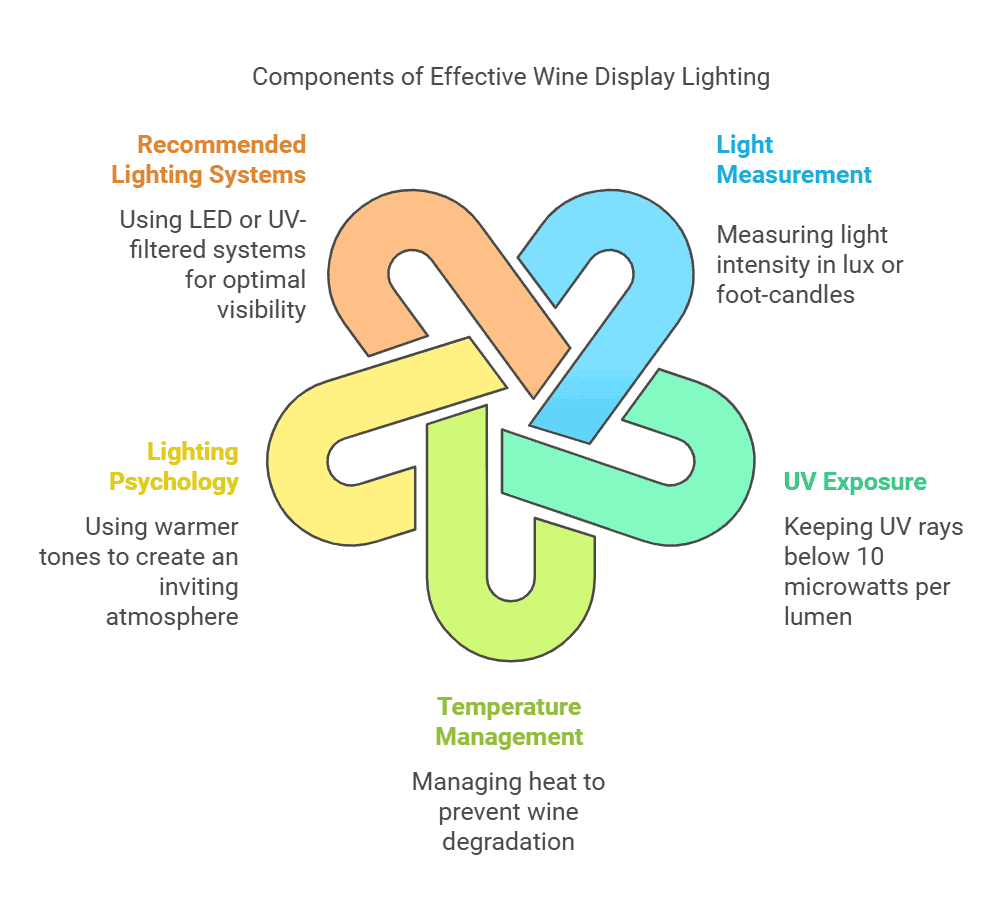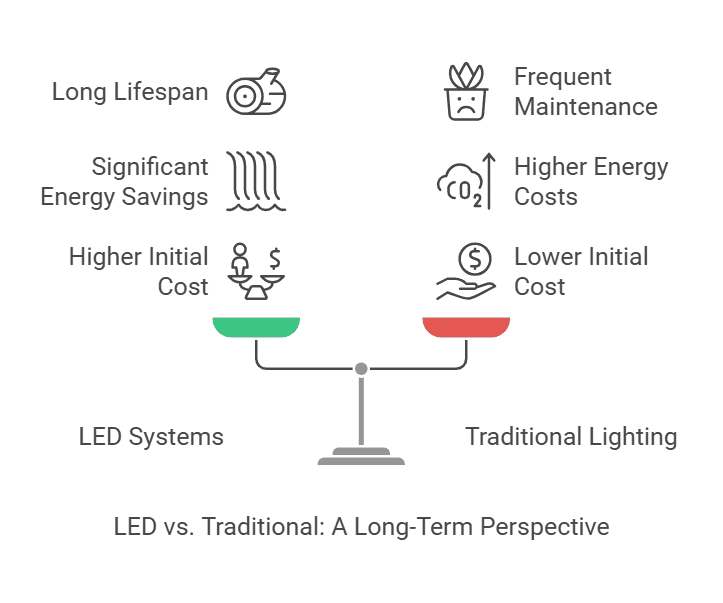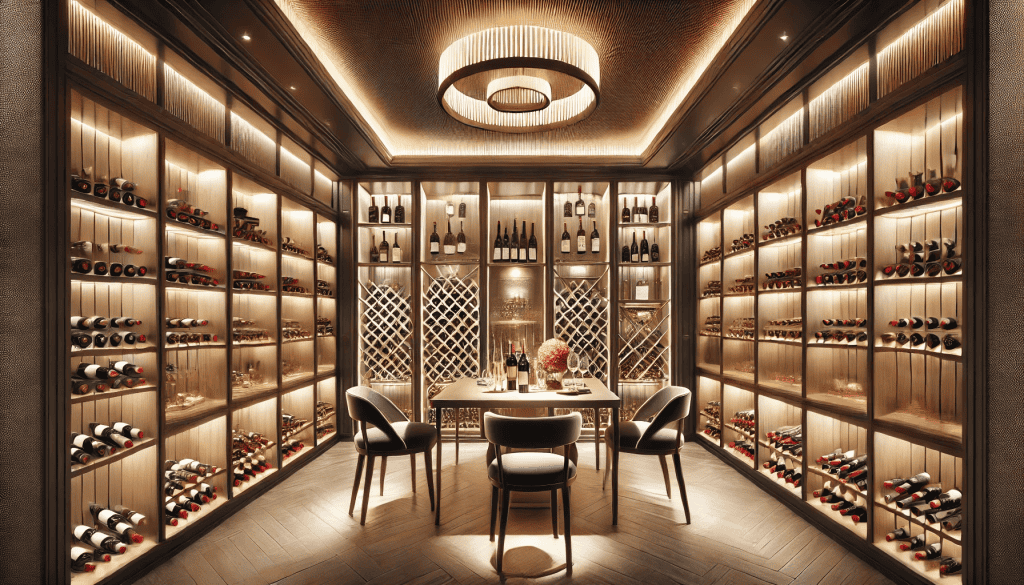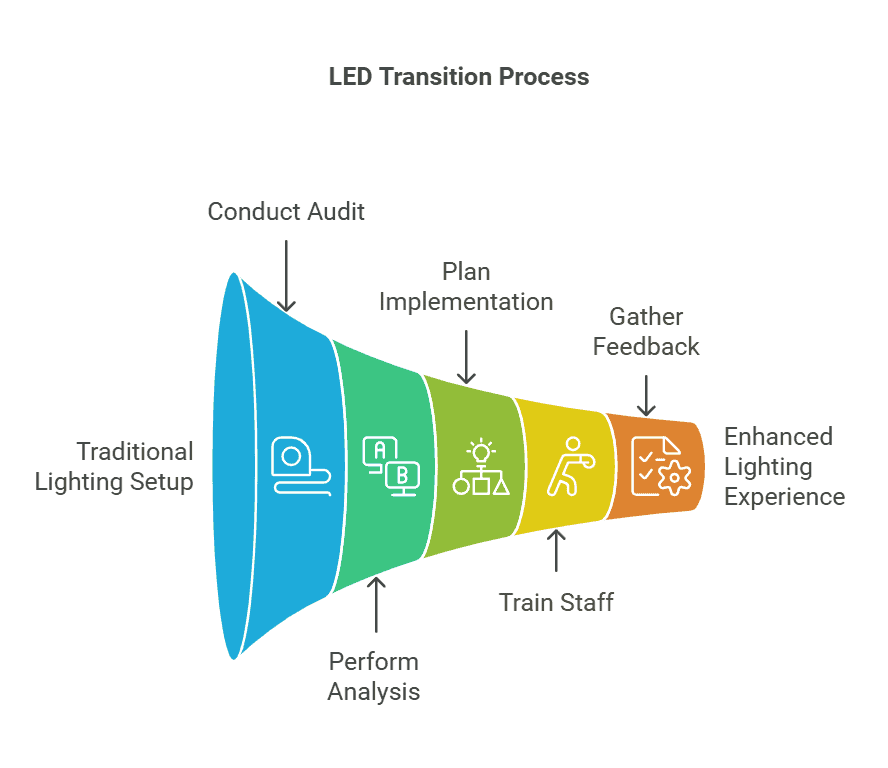Did you know choosing the proper wine cellar lighting options can increase wine sales by up to 39% in commercial displays?
In the world of wine presentation, lighting isn’t just about illumination – it’s about creating an atmosphere that enhances the beauty of your collection while preserving its quality. The debate between LED and traditional lighting solutions has become increasingly relevant as businesses seek to balance aesthetics, energy efficiency, and wine preservation.
Let’s explore how these lighting options stack up against each other and help you make an informed decision for your commercial wine display.
Welcome to Didi Somm, and Cheers!
Important Notice: The information in this article is for general and public information purposes only. It solely reflects Didi Somm’s or his Staff’s opinion, and no responsibility can be assumed for errors or omissions in the service’s contents. For details, please check the Disclaimer at the bottom of the homepage.

Key Takeaways
- LED lighting offers superior energy efficiency and longevity compared to traditional options
- Traditional lighting creates a warm, classic ambiance but requires more maintenance
- Temperature control is crucial for wine preservation regardless of lighting choice
- Modern LED solutions can now mimic traditional lighting warmth
- Initial investment varies significantly between lighting types
Understanding Wine Display Lighting Fundamentals
Having spent over 15 years in wine display design, I’ve learned that proper lighting is absolutely crucial for wine preservation and presentation.
Light exposure, particularly UV rays, can significantly impact wine quality by triggering chemical reactions that affect taste and aging. When I first started designing wine displays, I made the mistake of using standard retail lighting – boy, was that a learning experience!
Let me share what I’ve discovered about the fundamentals. The most critical factor is understanding light measurement:
We typically measure light intensity in lux or foot-candles, with recommended levels for wine displays ranging between 50-100 lux. UV exposure should be kept below 10 microwatts per lumen to prevent wine degradation.
Temperature is another crucial factor – even small variations can affect wine quality, and lighting plays a huge role in heat management. In retail environments, I’ve found that lighting psychology is fascinating – warmer tones (2700K-3000K) tend to create a more inviting atmosphere and can increase browsing time by up to 33%.
Current industry standards recommend LED or UV-filtered lighting systems that maintain consistent temperature while providing optimal visibility for label reading.

Traditional Lighting Solutions: A Classic Approach
When it comes to traditional lighting solutions for wine displays, I’ve worked with everything from halogen to incandescent and fluorescent options. Each type brings its own charm to the table.
Halogen Lights
Halogen lights, which I used extensively in my early projects, provide that warm, inviting glow that many clients absolutely love – they make those Bordeaux labels practically glow! However, they’re not without their drawbacks.
Traditional Light Bulbs
The heat generation from traditional bulbs is significant; I once recorded a 3-4°F temperature increase in a display case using halogen lights. Installation is relatively straightforward, but maintenance can be a pain – bulbs typically need replacement every 2,000-5,000 hours, depending on usage.
Cost-wise, while the initial investment might seem attractive (roughly $5-15 per bulb), the long-term operational costs can add up fast. I’ve calculated that traditional lighting systems can cost anywhere from $800-1,200 annually in electricity and maintenance for a medium-sized display.
LED Technology in Wine Displays
The LED revolution has completely transformed how we approach wine display lighting. I remember installing my first LED system back when the technology was just emerging – the difference in energy consumption and heat emission was mind-blowing.
Modern LED Solutions
Modern LED solutions offer incredible flexibility with color temperature options ranging from 2700K to 6500K, though I typically recommend staying in the warmer spectrum for wine displays. The energy efficiency is remarkable; I’ve seen clients reduce their lighting energy consumption by up to 80% after switching to LEDs.
Heat Emission
Heat emission is minimal – typically less than 1°F temperature increase in display cases – making them ideal for temperature-sensitive wine storage.
Smart Integration
Smart integration capabilities have opened up exciting possibilities; I recently completed a project where the LED system automatically adjusts based on ambient light conditions and store hours, creating the perfect ambiance while maximizing energy savings.
Comparative Analysis: LED vs. Traditional
Let’s break down the numbers based on real-world experience.
Initial Investment
The initial investment for LED systems typically ranges from $1,500-3,000 for a medium-sized display, compared to $500-1,000 for traditional lighting. However, the long-term savings are significant. I’ve tracked operational costs across multiple installations, and LEDs consistently deliver 60-80% reduction in energy costs.
Maintenance
Maintenance requirements differ dramatically – traditional systems need bulb replacement every 6-12 months, while LED systems can run for 40,000-50,000 hours (that’s about 11-14 years of normal use!).
Environmental Impact
Environmental impact is another crucial factor; LED systems reduce carbon footprint by approximately 70% compared to traditional lighting. Light quality remains consistent with LEDs, while traditional bulbs tend to degrade over time, affecting color rendering and intensity.

Design Considerations and Implementation
Space optimization is crucial in wine display design, and lighting plays a pivotal role.
I’ve found that layered lighting approaches work best – combining ambient, accent, and task lighting to create depth and visual interest. When highlighting featured wines, I typically recommend positioning LED spots at a 30-45 degree angle to minimize glare while maximizing label visibility.
Creating distinct lighting zones helps guide customer attention and improves traffic flow – I’ve seen sales increase by up to 25% when implementing well-planned lighting zones.
Architectural integration can be tricky, but I’ve developed a technique of using hidden LED strips along shelf edges that provide excellent illumination while maintaining clean lines.
For display cases, it’s essential to consider ventilation patterns and heat dissipation when positioning lights.

Making the Switch: Transition Strategies
Transitioning from traditional to LED lighting requires careful planning and execution.
I always start with a comprehensive audit of the existing setup, measuring current light levels and energy consumption to establish a baseline. The cost-benefit analysis typically shows a break-even point within 2-3 years, though I’ve seen some clients recoup their investment even faster through energy savings and reduced maintenance costs.
Implementation should be phased to minimize disruption – I usually recommend starting with a small section to allow staff and customers to adjust to the new lighting. Staff training is crucial; they need to understand how to operate any new control systems and recognize the benefits to effectively communicate with customers.
Customer feedback has been invaluable in fine-tuning installations – I make it a point to survey regular customers before and after the transition to ensure the new lighting enhances their shopping experience.

FAQ – Wine Cellar Lighting Options
- How do LED lights affect wine aging compared to traditional lighting? Answer: LED lights have minimal impact on wine aging compared to traditional lighting because they emit significantly less heat and UV radiation. LEDs typically operate at lower temperatures and can be specifically designed to eliminate UV emissions, which can cause wine to age prematurely or develop off-flavors.
- What is the average ROI when switching to LED wine display lighting? Answer: The average ROI for switching to LED wine display lighting is typically 2-3 years. Businesses can expect to save 60-80% on energy costs and significantly reduce maintenance expenses, with LED bulbs lasting up to 50,000 hours compared to traditional bulbs’ 2,000-hour lifespan.
- Can LED lights replicate the warm ambiance of traditional lighting? Answer: Yes, modern LED technology can effectively replicate the warm ambiance of traditional lighting through adjustable color temperatures (typically 2700K-3000K) and advanced color rendering capabilities. Many LED systems now offer customizable settings to match the desired atmosphere.
- How often should wine display lighting be maintained? Answer: LED wine display lighting typically requires maintenance every 3-5 years, while traditional lighting needs attention every 6-12 months. Regular cleaning of fixtures should be performed quarterly regardless of the lighting type to ensure optimal performance.
- What is the ideal color temperature for wine display lighting? Answer: The ideal color temperature for wine display lighting ranges from 2700K to 3000K, providing a warm, inviting atmosphere that enhances the appearance of both red and white wines without affecting their quality.
- Do LED lights emit harmful UV rays that can damage wine? Answer: No, quality LED lights designed for wine displays do not emit harmful UV rays. They can be specifically manufactured to eliminate UV emissions, making them safer for long-term wine storage compared to traditional lighting options.
- How much can businesses save on energy costs with LED lighting? Answer: Businesses can typically save 60-80% on energy costs by switching to LED lighting. For a medium-sized wine display, this could translate to annual savings of $500-$1,500, depending on local energy rates and usage patterns.
- What are the primary differences in installation requirements? Answer: LED installations generally require less complex wiring and fewer power sources due to their lower energy consumption. However, they may need specific drivers and compatibility checks. Traditional lighting requires more robust electrical infrastructure and heat management considerations.
- Can existing traditional lighting fixtures be converted to LED? Answer: Yes, most traditional fixtures can be retrofitted with LED bulbs or strips using conversion kits. However, for optimal performance and longevity, it’s often recommended to install purpose-built LED fixtures designed specifically for wine displays.
- How long do LED wine display lights typically last? Answer: Quality LED wine display lights typically last 40,000-50,000 hours (approximately 11-14 years with 12-hour daily use), compared to traditional bulbs that last 2,000-5,000 hours.
- What safety considerations should be taken into account? Answer: Key safety considerations include proper heat management, electrical load calculations, emergency lighting integration, and ensuring all installations meet local building codes and fire safety regulations.
- Are there specific lighting regulations for commercial wine displays? Answer: Yes, commercial wine displays must comply with local building codes, energy efficiency standards, and food safety regulations. Some jurisdictions have specific requirements for lighting in alcohol retail spaces.
- How does lighting affect customer behavior in wine retail? Answer: Proper lighting can increase browsing time by up to 33% and sales by 39%. Well-lit displays create an inviting atmosphere, enhance label readability, and help customers feel more confident in their selection process.
- What are the best practices for lighting temperature-controlled areas? Answer: Best practices include using cool-running lights, maintaining adequate spacing between lights and bottles, installing sensors for automatic adjustment, and ensuring proper ventilation to maintain consistent cellar temperatures.
- Can LED lighting systems be integrated with smart home technology? Answer: Yes, modern LED systems can be integrated with smart technology, allowing for remote control, scheduling, motion sensing, and integration with broader building management systems for optimal efficiency.
Conclusion
The choice between LED and traditional lighting for commercial wine displays ultimately depends on your specific needs, budget, and aesthetic preferences.
While LED technology offers compelling advantages in terms of energy efficiency and maintenance, traditional lighting solutions continue to provide their unique charm and ambiance. Consider your long-term goals, energy costs, and display requirements when making this important decision.
Remember, the right lighting not only preserves your wine collection but also enhances the overall customer experience and can significantly impact your bottom line.
Good luck and Cheers!
For your reference, the latest articles by Didi Somm include:
- Guide to Commercial Wine Storage: Best Expert Insights
- Retail Wine Storage Solutions: Best Expert Advice
- Wine Locker Storage Explained. Best Expert Guide For You
- Commercial Wine Cellar Organization – Best Expert Guide
- Best Commercial Wine Coolers – Top Expert Choices For You
- Commercial Wine Cellar Humidity – Best Expert Advice
Important Notice: The information in this article is for general and public information purposes only. It solely reflects Didi Somm’s or his Staff’s opinion, and no responsibility can be assumed for errors or omissions in the service’s contents. For details, please check the Disclaimer at the bottom of the homepage.


